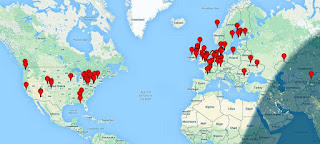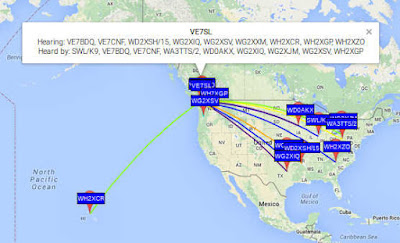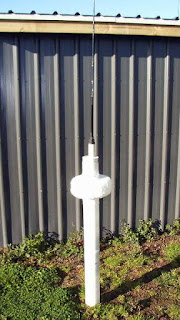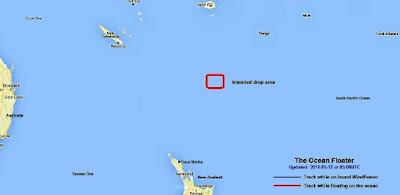Posts Tagged ‘JT9’
 630m – The Path To VK
630m – The Path To VK
 |
| Roger, VK4YB |
I've been exchanging e-mails lately with Roger, VK4YB, in Queensland, Australia.
Roger is located about 30 miles from the ocean and has been the only VK signal that I have been able to hear on 630m WSPR mode. He seems to have the strongest signal out of Australia on 630m with his 90 watts and 120' tree supported wire vertical. John, VE7BDQ, has been heard twice down under with his modest station running at the allowable 5W EIRP limit, being reported in the fall of 2015 and again this spring. As well, John has heard Roger, the only signal from VK that either of us has copied.
I would like to be able to run some schedules with Roger in the fall, when transpacific paths should peak again. With that in mind, construction has begun on a new 630m transverter that will allow me to drive my present FET amplifier at full EIRP. Our schedules will utilize the JT9 weak signal mode, similar to JT65 but designed for the noisier LF and MF bands. It uses about 10% of the bandwidth that a JT65 signal requires, about 15Hz, and gains about 2db more sensitivity. A two-way QSO, under the best conditions, would take four minutes if all went well. A typical exchange of the required information, if initiated at my end, would look something like this:
VK4YB VE7SL
VE7SL VK4YB -20
R -18
RR 73
73 73 (not really needed but indicates RR received)
The path from my end is difficult as I am on the east side of Mayne Island and in Roger's direction, about one mile from a 600' hill directly in line with VK. Any RF heading Roger's way will need to leave here at a fairly high angle, which is likely the case anyway considering the low and short (in terms of wavelength) inverted-L antenna.
The path profile from here to the open Pacific Ocean is shown below, with my end being on the right edge, just behind those two hills. The rest of the obstructions are on Saltspring Island and then Vancouver Island, before hitting open water.
 |
| VE7SL To VK4YB courtesy: Hey What's That Path Profiler |
 |
| W7IUV To VK4YB courtesy: Hey What's That Path Profiler |
 |
| To VK4YB courtesy: Hey What's That Path Profiler |
The path from John, VE7BDQ, already heard in VK, is also easier than from here. Not far from the water, John has a pretty clear shot across Georgia Strait, giving his signal lots of time to gain altitude and clear those pesky Vancouver Island peaks.
 |
| VE7BDQ To VK4YB courtesy: Hey What's That Path Profiler |
 |
| VE7CNF To VK4YB courtesy: Hey What's That Path Profiler |
 |
| VA7MM To VK4YB courtesy: Hey What's That Path Profiler |
 |
| VE7CA To VK4YB courtesy: Hey What's That Path Profiler |
 |
| VK4YB Path To Pacific courtesy: Hey What's That Path Profiler |
As the solar activity slowly abates (but not this week!), propagation on 630m will slowly get better and better ... hopefully along with increased levels of Canadians transmitting on the band, and lots of stations in the USA. It is hoped that our enthusiastic neighbours to the south aren't too far away from getting the band fairly soon. Better get those soldering irons warmed-up so you are all ready to go!
 CW Forever …?
CW Forever …?
 |
| 24 Hour 'JT' 6m Activity |
The transverter develops just over 70 watts output when run on 13V and so far, has been able to take all of the nightly punishment I've been able to throw at it with flying colors. Here is a WSPRnet screen shot taken from a typical night of my WSPR beaconing on 630m:
 |
| courtesy: KB5NJD's 630m Info |
I was also able to have my first JT-9 mode QSO this week, with Toby, VE7CNF. This mode is the weak-signal WSPR QSO mode, tailored for LF/MF work and allows for calls, signal reports and confirmations (R's) to be exchanged ... the minimum requirements needed to claim a contact. Although additional information can be exchanged, its 13-letter message buffer does not exactly promote ragchew style conversations and some creativity is required to exchange more than the basics.
With many of our newer 'digital-savy' amateurs not necessarily being proficient in CW, I suspect that JT-9 may well evolve to become the go-to weak signal communication mode on 630m, much as it has in Europe. In fact, popularity of this mode in Europe has already spawned a few JT-9 contest weekends on 630m, with high activity levels being reported. I'm really looking forward to a 630m JT-9 QSO party in North America, once the band becomes a reality in the U.S.A.
JT-9 is capable of decoding signals reliably down to -24db SNR and boasts a 50% reliability of decoding at -26db SNR. Audible CW drops out at around -16 to -18db SNR, so communicating with JT-9 is the equivalent of going from 100 watts to around 800 watts ... a significant improvement and very helpful on 630m! Like WSPR, JT-9 will work with non-linear transverters and amplifiers such as the commonly-used and simple to build switching MOSFET Class D/E styles.
There also appears to be a fast-growing use of JT-65A on the 6m band this summer, with numerous 'CW forever' operators finding the mode's ability to dig up to 10db deeper into the noise paying off with surprising results. Some western North American operators have noticed that European JT-65A signal levels indicate that they should be in the CW-copiable range yet no CW activity is heard, for which there seems to be no ready explanation. Perhaps more will be learned this summer as the use of this mode continues to expand.
As one of the 'CW forever' proponents willing to try something different, I also have been listening for and working stations on 6m over the past few days on JT-65A. With the IC-756ProIII throttled back to 25 watts, I've found it fairly easy to make contacts when the band is open but have yet to hear or work anything unusual.
I'd love to hear your own comments on the use of JT-9 or JT-65A, particularly on 630m or on 6m ... maybe you can pass along some tips for those of us that are new to the mode on this band.
I may have to reconsider this 'CW forever' thing!
 LHS Episode #170: Invasion of the Random Dog
LHS Episode #170: Invasion of the Random Dog
 It's our post-Hamvention episode and it's packed with great information. We start off with a look at hams in the news, special event stations for all Canadian operators, the legalities and procedures for proper third-party operation. Then we move into a comparison of Linux live update procedures and the latest news about Raspberry Pi Zero boards. Then we take a tour of the JT9 and JT65 digital modes using WSJT-X. And there's so much more. Thanks for listening!
It's our post-Hamvention episode and it's packed with great information. We start off with a look at hams in the news, special event stations for all Canadian operators, the legalities and procedures for proper third-party operation. Then we move into a comparison of Linux live update procedures and the latest news about Raspberry Pi Zero boards. Then we take a tour of the JT9 and JT65 digital modes using WSJT-X. And there's so much more. Thanks for listening!
73 de The LHS Crew
 The ZL1SIX Ocean Floater
The ZL1SIX Ocean Floater

For those of you that are fans of the low-powered "party balloon" floaters, such as the recent S-9 flight by VE3KCL, now comes a different kind of floater and one that really does float ... on the Pacific Ocean!
The "Ocean Floater" is the work of Bob, ZL1RS, who has been very active in tracking the other floaters from his excellent receiving site down-under. Like the balloons, Bob's beacon also utilizes the QRP Labs U3S hardware to transmit data in both WSPR and JT9 modes. The little beacon runs ~100mw on the 30m WSPR band and tracking this one will likely be a bit more challenging than following the high-flying balloons.
 |
| Bob's 'Ocean Floater courtesy: http://www.qsl.net/zl1rs/oceanfloater.html |
Here is Bob's description as he posted to Yahoo Groups QRP Labs:
A small project inspired by Hans' Voyager ideas at
http://www.hanssummers.com/voyager.html ... the Floater is a 100mW
transmitter on the 30m band with a short base-loaded whip antenna
mounted on a buoy that will drift in the Pacific Ocean. It is sending a
standard WSPR transmission once and hour, followed by two JT9
transmissions giving its position, the temperature, and the battery voltage.
The project was deliberately kept very simple. A QRP-Labs U3S
transmitter and firmware made the electronics side easy. The U3S was
rebuilt on a board with a more open layout to allow experimentation and
the addition of a PICAXE controller to switch things on/off as required
to reduce overall battery consumption. Most of the "hard work" was in
the buoy body and antenna. More information about how this went
together can be found at http://www.qsl.net/zl1rs/oceanfloater.html
Today the Floater left on the yacht Windflower to be released into the
south-west Pacific Ocean in a few days time. This will ensure the
Floater is well clear of the coastal currents around ZL that would
otherwise have 'beached' it along the coast if it been launched from the
shore. Unlike balloon flights, things will happen very very slowly, so
updates to the webpage and tracking map will probably only be made on a
daily basis. WSPRnet spots will show the 4 character Maidenhead
locator position, and the JT9 decodes have a 6 character Maidenhead
resolution. Any JT9 decodes you receive will be appreciated via e-mail
to [email protected]
73, Bob ZL1RS
The beacon will use the call "ZL1SIX" and will be launched shortly, near Minerva Reef. Watch Bob's website for tracking and updates and ... good luck Bob!
 VK4YB Lights Up West Coast On 630m
VK4YB Lights Up West Coast On 630m
 The past few weeks have seen many of the VK 630m WSPR stations making it into North America's west coast and points east. VK2DDI, VK2XGJ, VK3ELV and VK4YB have been the signals most often seen. Particularly dominant is the signal from Roger, VK4YB, the northern-most station, located in Moorina, Queensland, near the Pacific Ocean.
The past few weeks have seen many of the VK 630m WSPR stations making it into North America's west coast and points east. VK2DDI, VK2XGJ, VK3ELV and VK4YB have been the signals most often seen. Particularly dominant is the signal from Roger, VK4YB, the northern-most station, located in Moorina, Queensland, near the Pacific Ocean.Roger's signal has been decoded locally by myself as well as VE7BDQ and VA7MM, creating excitement over the more normal nightly spots from the central states.
2016-04-13 11:10 VK4YB 0.475646 -28 QG62ku 5 VA7MM CN89og
2016-04-13 11:20 VK4YB 0.475647 -29 QG62ku 5 VA7MM CN89og
2016-04-13 11:28 VK4YB 0.475647 -28 QG62ku 5 VA7MM CN89og
2016-04-13 11:28 VK4YB 0.475644 -23 QG62ku 5 VE7BDQ CN89la
2016-04-13 11:36 VK4YB 0.475644 -26 QG62ku 5 VE7BDQ CN89la
2016-04-13 11:52 VK4YB 0.475643 -25 QG62ku 5 VE7BDQCN89la
2016-04-13 11:56 VK4YB 0.475643 -28 QG62ku 5 VE7BDQ CN89la
2016-04-07 08:54 VK4YB 0.475643 -25 QG62ku 5 VE7SL CN88iu
2016-04-07 09:36 VK4YB 0.475644 -29 QG62ku 5 VE7SL CN88iu
2016-04-07 10:08 VK4YB 0.475644 -29 QG62ku 5 VE7SL CN88iu
2016-04-07 10:18 VK4YB 0.475644 -29 QG62ku 5 VE7SL CN88iu
2016-04-07 11:04 VK4YB 0.475644 -29 QG62ku 5 VE7SL CN88iu
2016-04-13 11:06 VK4YB 0.475644 -24 QG62ku 5 VE7SL CN88iu
2016-04-13 11:10 VK4YB 0.475644 -23 QG62ku 5 VE7SL CN88iu
2016-04-13 11:20 VK4YB 0.475644 -23 QG62ku 5 VE7SL CN88iu
2016-04-13 11:28 VK4YB 0.475644 -28 QG62ku 5 VE7SL CN88iu
2016-04-13 11:32 VK4YB 0.475644 -25 QG62ku 5 VE7SL CN88iu
2016-04-13 11:52 VK4YB 0.475643 -18 QG62ku 5 VE7SL CN88iu
2016-04-13 11:56 VK4YB 0.475643 -22 QG62ku 5 VE7SL CN88iu
2016-04-13 12:16 VK4YB 0.475643 -27 QG62ku 5 VE7SL CN88iu
2016-04-13 12:28 VK4YB 0.475643 -26 QG62ku 5 VE7SL CN88iu
2016-04-13 12:32 VK4YB 0.475643 -25 QG62ku 5 VE7SL CN88iu
2016-04-13 12:54 VK4YB 0.475644 -24 QG62ku 5 VE7SL CN88iu
2016-04-13 12:58 VK4YB 0.475643 -24 QG62ku 5 VE7SL CN88iu
2016-04-13 13:10 VK4YB 0.475643 -25 QG62ku 5 VE7SL CN88iu
2016-04-13 13:24 VK4YB 0.475643 -27 QG62ku 5 VE7SL CN88iu
2016-04-13 13:28 VK4YB 0.475643 -27 QG62ku 5 VE7SL CN88iu
Roger has sent the following information to me regarding his well-planned system:
My QTH is atop of a stony ridge on 10 acres. The previous owner said there was some soil somewhere, but I haven't found it yet! Ground conductivity is very poor, I think. If you drive in two stakes about six inches apart, an ohmmeter says infinity. That's if you can drive in a stake. Because after the first quarter inch you hit shale rock. Interestingly the shale layers are at about 60 degrees to the horizontal. There are some quartz inclusions. Yes, I have tried crushing the quartz and panning it - no gold!
Getting back to my story, I needed to put up a 630m antenna in a hurry. The idea of winding a big loading coil with the rotatable inner coil was a bit daunting. And putting down ground radials or an earth mat was out of the question. So, using only some wire, string and a bow and arrow, this is what I came up with:
I estimate the feed point impedance is about 3000 ohms. The ATU has 48 turns on the secondary, tuned by fixed capacitors of 960 pF in parallel with a 500 pF variable which is about two thirds meshed. The primary is 5 turns fed by the transverter having a 50 ohm nominal output. The impedance at the top of the secondary should be near 5000 ohms, but the antenna feed wire is tapped about two thirds of the way up the secondary coil, which gives 1.03 : 1 SWR. The earthy end of the coil is connected to the mains earth and the metal work of the shed. I haven't tried terminating the far end. I did think about connecting it to the fence wire that runs round the property but I thought that might be a bit dangerous. There would be high voltage points in places. The transverter output is nominally 50 watts, but it is giving about 90 watts in reality.
 |
| Roger - VK4YB |
 Some Radio Antics
Some Radio Antics
Thankfully things calmed down and was able to put the antenna back up but I seemed a little deaf on VHF/UHF dropping several S-points on local repeaters and then started to see high VSWR readings. The incessant rain had somehow got into the connector under the collinear despite being generously wrapped in self amalgamating tape. I replaced the connector and removed a couple of feet of coax in case any had seeped into the cable.
Like much of the UK amateur community I have been trying to listen in to British Astronaut Major Tim Peake during a number of ARISS UK school contacts during the Principia mission on the International Space Station. It is pleasing to see the enthusiasm, interest and publicity it has generated for the hobby.
There is another contact tomorrow (Friday 26th February 2016 at 1440UTC) with the City of Norwich School. While reception of the first two contacts proved a little disappointing for me, the one last week was much better and I made a video during the pass.
The Astronauts are certainly busy on the space station and there was an ARISS contact this morning with an Italian school. It was a low pass here only reaching 7 degrees above the horizon but was pleased to capture Tim Kopra conversing. I was using just the X-50 collinear on the FT857-D
The repaired ATU and a new balun on the OCFD has made a big difference to HF. It is much less noisy and I am now able to match the antenna to 80m something I could never do before. While it will be very inefficient on such a short antenna I did run a little over 2W last night on WSPR as a test, and was pleasantly surprised.
I have also been doing some JT65 and for the first time some JT9 inspired by a demonstration at SKARS and I was pleased to make a JT9 QSO with JA5BDZ on 15m using 10W.
A big help to HF has been tracking down the source of my recent QRM, which wasn't as many suggested my evil PLT devices but in fact the now redundant wireless router. While the WiFi was switched off it was still being used as a network switch and for some reason had suddenly become RF noisy, it wasn't the switching PSU but the actual unit and would happen a few hours after being switched on. Funny thing it is not the first time I've had an access point suddenly emit QRM.
A couple of weeks ago I went out with Stewart (M0SDM) to assist him flying his kite antenna and we operated under the club callsign MX0SKR, for a couple of hours, it was great fun.
Last weekend I also helped my brother David (M6GTD) install a couple of antennas at the family home. He can finally use the radio he brought at the Hamfest back in September, a Diamond X-50 dual band collinear and a home brewed 33ft long OCFD should get him on the air!
David helped me at the Hamfest with the balloon launch
My apologies if this blog post sounds like a bit like an excited child recanting his holiday "I did this, and then I did this and I also did that" I hope to post something a little more coherent and structured soon!
 Some Radio Antics
Some Radio Antics
Thankfully things calmed down and was able to put the antenna back up but I seemed a little deaf on VHF/UHF dropping several S-points on local repeaters and then started to see high VSWR readings. The incessant rain had somehow got into the connector under the collinear despite being generously wrapped in self amalgamating tape. I replaced the connector and removed a couple of feet of coax in case any had seeped into the cable.
Like much of the UK amateur community I have been trying to listen in to British Astronaut Major Tim Peake during a number of ARISS UK school contacts during the Principia mission on the International Space Station. It is pleasing to see the enthusiasm, interest and publicity it has generated for the hobby.
There is another contact tomorrow (Friday 26th February 2016 at 1440UTC) with the City of Norwich School. While reception of the first two contacts proved a little disappointing for me, the one last week was much better and I made a video during the pass.
The Astronauts are certainly busy on the space station and there was an ARISS contact this morning with an Italian school. It was a low pass here only reaching 7 degrees above the horizon but was pleased to capture Tim Kopra conversing. I was using just the X-50 collinear on the FT857-D
The repaired ATU and a new balun on the OCFD has made a big difference to HF. It is much less noisy and I am now able to match the antenna to 80m something I could never do before. While it will be very inefficient on such a short antenna I did run a little over 2W last night on WSPR as a test, and was pleasantly surprised.
I have also been doing some JT65 and for the first time some JT9 inspired by a demonstration at SKARS and I was pleased to make a JT9 QSO with JA5BDZ on 15m using 10W.
A big help to HF has been tracking down the source of my recent QRM, which wasn't as many suggested my evil PLT devices but in fact the now redundant wireless router. While the WiFi was switched off it was still being used as a network switch and for some reason had suddenly become RF noisy, it wasn't the switching PSU but the actual unit and would happen a few hours after being switched on. Funny thing it is not the first time I've had an access point suddenly emit QRM.
A couple of weeks ago I went out with Stewart (M0SDM) to assist him flying his kite antenna and we operated under the club callsign MX0SKR, for a couple of hours, it was great fun.
Last weekend I also helped my brother David (M6GTD) install a couple of antennas at the family home. He can finally use the radio he brought at the Hamfest back in September, a Diamond X-50 dual band collinear and a home brewed 33ft long OCFD should get him on the air!
David helped me at the Hamfest with the balloon launch
My apologies if this blog post sounds like a bit like an excited child recanting his holiday "I did this, and then I did this and I also did that" I hope to post something a little more coherent and structured soon!

















